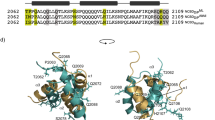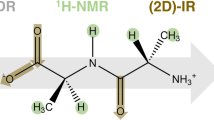Abstract
The three dimensional solution structure of the carboxy terminal LIM domain of the avian Cysteine Rich Protein (CRP) has been determined by nuclear magnetic resonance spectroscopy. The domain contains two zinc atoms bound independently in CCHC (C=Cys, H=His) and CCCC modules. Both modules contain two orthogonally-arranged antiparallel β-sheets, and the CCCC module contains an α-helix at its C terminus. The modules pack due to hydrophobic interactions forming a novel global fold. The structure of the C-terminal CCCC module is essentially identical to that observed for the DNA-interactive CCCC modules of the GATA-1 and steroid hormone receptor DNA binding domains, raising the possibility that the LIM motif may have a DNA binding function.
This is a preview of subscription content, access via your institution
Access options
Subscribe to this journal
Receive 12 print issues and online access
$189.00 per year
only $15.75 per issue
Buy this article
- Purchase on Springer Link
- Instant access to full article PDF
Prices may be subject to local taxes which are calculated during checkout
Similar content being viewed by others
References
Karlsson, O., Thor, S., Norberg, T., Ohlsson, H. & Edlund, T. Insulin gene enhancer binding protein Isl-1 is a member of a novel class of proteins containing both a homeo- and a cys-his domain. Nature 344, 879–882 (1990).
Freyd, G., Kim, S.K. & Horvitz, R. Novel cysteine-rich motif and homeodomain in the product of the Caenorhabditis elegans cell lineage gene lin-11 . Nature 344, 876–879 (1990).
Xu, Y., Baldassare, M., Fisher, P., Rathbun, G., Oltz, E.M., Yancopoulos, G.D., Jessell, T.M. & Alt, F.W. LH-2: a LIM/homeodomain gene expressed in developing lymphocytes and neural cells. Proc. natn. Acad. Sci. U.S.A. 90, 227–231 (1993).
Bourgouin, C., Lundgren, S.E. & Thomas, J.B. Apterous is a drosophila LIM domain gene required for the development of a subset of embryonic muscles. Neuron 9, 549–561 (1992).
Cohen, B., McGuffin, M.E., Pfeifle, C., Segal, D. & Cohen, S.M. Apterous, a gene required for imaginal disc development in Drosophila encodes a member of the LIM family of developmental regulatory proteins. Genes Devel. 6, 715–729 (1992).
Taira, M., Jamrich, M., Good, P.J. & Dawid, I.B. The LIM domain-containing homeo box gene Xlim-1 is expressed specifically in the organizer region of Xenopus gastrula embryos. Genes Devel. 6, 356–366 (1992).
Boehm, T., Greenberg, J.M., Buluwela, L., Lavenir, I., Forster, A. & Rabbitts, T.H. An unusual structure of a putative T cell oncogene which allows production of similar proteins from distinct mRNAs. EMBO J. 9, 857–868 (1990).
Birkenmeier, E.H., & Gordon, J.I. Developmental regulation of a gene that encodes a cysteine-rich intestinal protein and maps near the murine immonoglobulin heavy chain locus. Proc. natn. Acad. Sci. USA 83, 2516–2520 (1986).
Sadler, I., Crawford, A.W., Michelsen, J.W. & Beckerle, M.C. Zyxin and cCRP: two interactive LIM domain proteins associated with the cytoskeleton. J. cell. Biol. 119, 1573–1587 (1992).
Liebhaber, S.A., Emery, J.G., Urbanek, M., Wang, X. & Cook, N.E. Characterization of a human cDNA encoding a widely expressed and highly conserved cysteine-rich protein with an unusual zinc-finger motif. Nucl. Acids Res. 18, 3871–3879 (1990).
Crawford, A.W., Pino, J.D. & Beckerle, M.C. Biochemical and molecular characterization of the chicken cysteine-rich protein, a developmentally regulated LIM-domain protein that is associated with the actin cytoskeleton. J. cell. Biol. 124, 117–127 (1994).
McGuire, A.E. et al. The t (11;14) p15;q11) in a T-cell acute lymphoblastic leukemia cell line activates multiple transcripts, including ttg-1, a gene encoding a potential zinc finger protein. Molec. cell. Biol. 9, 2124–2532 (1989).
Wang, X., Lee, G., Liebhaber, S.A. & Cooke, N.E. Human cystein-rich protein. A member of the LIM/double-finger family displaying coordinate serum induction with c-myc . J. biol. Chem. 267, 9176–9184 (1992).
Weiskirchen, R. & Bister, K. Suppression in transformed avian fibroblasts of a gene (crp) encoding a cysteine-rich protein containing LIM domains. Oncogene 8, 2317–2324 (1993).
Kosa, J.L. et al. Common metal ion coordination in LIM domain proteins. Biochemistry 33, 468–477 (1994).
Michelsen, J.W., Schmeichel, K.L., Beckerle, M.C. & Winge, D.R. The LIM motif defines a specific zinc-binding protein domain. Proc. natn. Acad. Sci. U.S.A. 90, 4404–4408 (1993).
Archer, V.E.V. et al. Cysteine-rich LIM domains of LIM-homeodomain and LIM-only proteins contain zinc but not iron. Proc. natn. Acad. Sci. U.S.A. 91, 316–320 (1994).
Wüthrich, K. NMR of Proteins and Nucleic Acids (John Wiley, New York, 1986).
Mueller, L. Sensitivity enhanced detection of weak nuclei using heteronuclear multiple quantum coherence. J. Am. chem. Soc. 101, 4481–4484 (1979).
Bax, A., Griffey, R.H. & Hawkins, B.L. Correlation of proton and nitrogen-15 chemical shifts by multiple quantum NMR. J. Magn. Reson. 55, 301–315 (1983).
Adman, E., Watenpaugh, E.D. & Jensen, L.H. NH—S hydrogen bonds in Peptococcus aerogenes ferredoxin, Clostridium pasteurianum rubredoxin, and Chromatium high potential iron protein. Proc. natn. Acad. Sci. U.S.A. 72, 4854 (1975).
South, T.L., Blake, P.R., Hare, D.R. & Summers, M.F. C-terminal retroviral-type zinc finger domain from the HIV-1 nucleocapsid protein is structurally similar to the N-terminal zinc finger domain Biochemistry 30, 6342–6349 (1991).
Summers, M.F., South, T.L., Kim, B. & Hare, D.R. Structure of an HIV-1 zinc fingerlike domain via a new NMR-based distance geometry approach. Biochemistry 29, 329–340 (1990).
Blake, P.R. & Summers, M.F. Probing the unusually similar metal coordination sites of retroviral zinc fingers and iron-sulfur proteins by nuclear magnetic resonance Adv. biophys. Chem. (in the press).
Fourmy, D., Dardel, F. & Blanquet, S. Methionyl-tRNA synthetase zinc binding domain Three-dimensional structure and homology with rubredoxin and gag retroviral proteins. J. molec. Biol. 231, 1078–1089 (1993).
Kochoyan, M., Havel, T.F., Nguyen, D.T., Dahl, C.E., Keutmann, H.T. & Weiss, M.A. Alternating zinc fingers in the human male associated protein ZFY: 2D NMR structure of an even-finger and implications for “jumping-linker” DNA recognition. Biochemistry 30, 3371–3386 (1991).
Kochoyan, M., Keutmann, H.G. & Weiss, M.A. Alternating zinc fingers in the human male associated protein ZFY: Refinement of the NMR structure of an even finger by selective deuterium labeling and implications for DNA recognition. Biochemistry 30, 7063–7072 (1991).
Lee, M.S., Gippert, G.P., Soman, D.A., Case, D.A. & Wright, P.E. Three-dimensional solution structure of a single zinc finger DNA-binding domain. Science 254, 635 (1989).
Hoffman, R.C., Xu, R., Klevit, R.E. & Herriott, J.R. A simple method for the refinement of models derived from NMR data demonstrated on a zinc-finger domain from yeast ADR1. J. magn. Reson. 102, 61–72 (1993).
Pavletich, N.P. & Pabo, C.O. Zinc finger-DNA recognition: Crystal structure of a Zif268-DNA complex at 2.1 Å. Science 252, 809–817 (1991).
Lee, M.S., Kliewer, S.A., Provencal, J., Wright, P.E. & Evans, R.M. Structure of the retinoid X receptor alpha DNA binding domain: A helix required for homodimeric DNA binding. Science 260, 1117 (1993).
Luisi, B.F. et al. Crystallographic analysis of the interaction of the glucocorticoid receptor with DNA. Nature 352, 497–505 (1991).
Knegtel, R.M.A. et al. The solution structure of the human retinoic acid receptor-β DNA-binding domain. J. biomolec. NMR 3, 1–17 (1993).
Schwabe, J.W.R., Neuhaus, D. & Rhodes, D. Solution structure of the DNA-binding domain of the oestrogen receptor. Nature 348, 458–461 (1990).
Hard, T. et al. Solution structure of the glucocorticoid receptor DNA-binding domain. Science 249, 157–160 (1990).
Baumann, H. et al. Refined solution structure of the glucocorticoid receptor DNA-binding domain. Biochemistry 32, 13463–13471 (1994).
Kraulis, P.J., Raine, A.R.C., Gadhavi, P.L. & Laue, E.D. Structure of the DNA-binding domain of zinc GAL4. Nature 356, 448–450 (1992).
Baleja, J.D., Marmorstein, R., Harrison, S.C. & Wagner, G. Solution structure of the DNA-binding domain of Cd2-GAL4 from S. cerevisiae . Nature 356, 450–453 (1992).
Marmorstein, R., Carey, M., Ptashne, M. & Harrison, S.C. DNA recognition by GAL4: structure of a protein–DNA complex. Nature 356, 408–414 (1992).
Omichinski, J.G. et al. NMR structure of a specific DNA complex of Zn-containing DNA binding domain of GATA-1. Science 261, 438–446 (1993).
Blake, P.B. et al. Heteronuclear magnetic resonance studies of Zn, 113Cd and 199Hg substituted P. furiosus rubredoxin: Implications for biological electron transfer. New J. Chem. 18, 387–395 (1994).
Blake, P.R., Park, J.B., Adams, M.W.W. & Summers, M.F. Novel observation of NH-S hydrogen bond mediated scalar coupling in 113Cd-substituted rubredoxin from the marine hyperthermophile, Pyrococcus furiosus . J. Am. chem. Soc. 114, 4931–4933 (1992).
Blake, P.R. et al. Quantitative measurement of small through-hydrogen-bond and ‘through-space’ 1H-113Cd and 1H-199Hg J couplings in metal-substituted rubredoxin from Pyrococcus furiosus . J. biomolec. NMR 2, 527–533 (1992).
Clore, G.M., Gronenborn, A.M., Nilges, M. & Ryan, C.A. Three-dimensional structure of potato carboxypeptidase inhibitor in solution. A study using nuclear magnetic resonance, distance geometry, and restrained molecular dynamics. Biochemistry 26, 8012–8023 (1987).
Blake, P.R. et al. Solution-state structure by NMR of zinc-substituted rubredoxin from the marine hyperthermophilic archaebacterium Pyrococcus furiosus . Prot. Sci. 1, 1508–1521 (1992).
Clore, G.M. & Gronenborn, A.M. Structures of larger proteins in solution: Three- and four-dimensional heteronuclear NMR spectroscopy. Science 252, 1390–1399 (1991).
Chakrabarti, P. Geometry of interaction of metal ions with histidine residues in protein structures. Prot. Engng. 4, 57–63 (1990).
Li, Y. & Tsai, M.-D. Phospholipase A2 engineering. 10. The aspartate-histidine catalytic diad also plays an important structural role. J. Am. chem. Soc. 115, 8523–8526 (1993).
Everett, R.D. et al. A novel arrangement of zinc-binding residues and secondary structure in the C3HC4 motif of an alpha herpes virus protein family. J. molec. Biol. 234, 1038–1047 (1993).
Barlow, P.N., Luisi, B., Milner, A., Elliott, M. & Everett, R. Structure of the C3HC4 domain by 1H-nuclear magnetic resonance spectroscopy. J. molec. Biol. 237, 201–211 (1994).
Griesinger, C., Otting, G., Wüthrich, K. & Ernst, R.R. Clean TOCSY for 1H spin system identification in macromolecules. J. Am. chem. Soc. 110, 7870–7872 (1988).
Hore, P.J. Solvent suppression in Fourier transform nuclear magnetic resonance. J. magn. Reson. 55, 283–300 (1983).
Brown, S.C., Weber, P.L. & Mueller, L. Toward complete 1H NMR spectra in proteins. J. magn. Reson. 77, 166–169 (1988).
Blake, P.R. et al. Determinants of protein hyperthermostability: purification and amino acid sequence of rubredoxin from the hyperthermophilic archaebacterium Pyrococcus furiosus and secondary structure of the zinc adduct by NMR. Biochemistry 30, 10885–10895 (1991).
Pauly, J., LeRoux, P., Mishimura, B. & Macovski, A. IEEE Trans. Med. Imaging 53, (1991).
Shinnar, M., Eleff, S., Subramanian, H. & Leigh, J.S. The synthesis of pulse sequences yielding arbitrary magnetization vectors. Magn. Reson. Med. 12, 74–80 (1989).
Kraulis, P.J. MOLSCRIPT: a program to produce both detailed and schematic plots of protein structures. J. appl. Crystallogr. 24, 946–950 (1991).
Bacon, D.J. & Anderson, W.F. A fast algorithm for rendering space-filling molecule pictures. J. molec. Graphics 6, 219–220 (1988).
Author information
Authors and Affiliations
Rights and permissions
About this article
Cite this article
Pérez-Alvarado, G., Miles, C., Michelsen, J. et al. Structure of the carboxy-terminal LIM domain from the cysteine rich protein CRP. Nat Struct Mol Biol 1, 388–398 (1994). https://doi.org/10.1038/nsb0694-388
Received:
Accepted:
Issue Date:
DOI: https://doi.org/10.1038/nsb0694-388
This article is cited by
-
Identification of novel FHL1 mutations associated with X-linked scapuloperoneal myopathy in unrelated Chinese patients
Journal of Human Genetics (2023)
-
Genome-Wide Identification and Characterization of LIM Gene Family in Grapevine (Vitis vinifera L.) and Their Expression Analysis at Early Bud Developmental Stages
Plant Molecular Biology Reporter (2023)
-
Two novel LHX3 mutations in patients with combined pituitary hormone deficiency including cervical rigidity and sensorineural hearing loss
BMC Endocrine Disorders (2017)
-
The plant LIM proteins: unlocking the hidden attractions
Planta (2017)
-
Bacterial metallothioneins: past, present, and questions for the future
JBIC Journal of Biological Inorganic Chemistry (2011)



